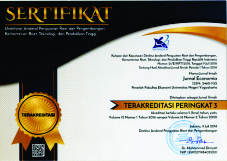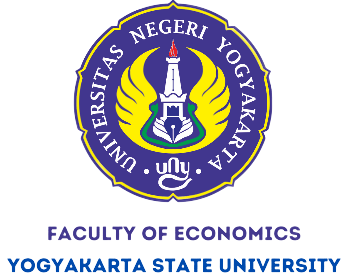Demographic Transition and Economic Growth in Indonesia
Downloads
Abstract: Demographic transition in Indonesia indicated by an increase in the productive age population, a decrease in the unproductive age population, and leads to a decrease in the dependency ratio. This study analyzes the relationship between demographic transition and Indonesia's economic growth. If the population structure changes contribute positively to economic development, it means that Indonesia has enjoyed a bonus from their demographic transition. The analysis used was multiple regression, with economic growth rate as dependent variable and population growth rate, capital, young age dependency ratio and old age dependency ratio as independent variables. This study has found that the demographic transition, represented by growth of young age dependency ratio, growth of capital, and economic crisis dummy variable partially contributes positively to economic growth. It can be concluded that the demographic transition in Indonesia provides a bonus that is in the form of a positive contribution to economic growth.
Keywords: economic growth, capital, population, dependency ratio
Transisi Demografi dan Pertumbuhan Ekonomi Indonesia
Abstrak: Transisi demografi di Indonesia ditandai dengan penurunan tingkat fertilitas dan mortalitas, yang berdampak pada peningkatan persentase penduduk usia produktif dan penurunan persentase penduduk usia tidak produktif. Hal ini menyebabkan angka beban tanggungan menjadi semakin kecil. Penelitian ini bertujuan untuk menganalisis hubungan transisi demografi dengan pertumbuhan ekonomi Indonesia. Jika transisi demografi berkontribusi positif pada pertumbuhan ekonomi, maka dapat dikatakan Indonesia telah menikmati bonus demografi. Model analisis menggunakan persamaan regresi, dengan pertumbuhan ekonomi sebagai variabel terikat. Variabel bebasnya adalah pertumbuhan penduduk, pertumbuhan modal, pertumbuhan dependency ratio penduduk usia muda, dan pertumbuhan dependency ratio penduduk usia lanjut. Hasil regresi menunjukkan bahwa transisi demografi yang diwakili oleh pertumbuhan dependency ratio penduduk usia muda, pertumbuhan modal, dan variabel dummy krisis ekonomi secara parsial berpengaruh positif terhadap perumbuhan ekonomi Indonesia. Hasil tersebut dapat disimpulkan bahwa transisi demografi memberikan bonus berupa kontribusi positif terhadap pertumbuhan ekonomi di Indonesia.
Kata kunci: pertumbuhan ekonomi, modal, penduduk, dependency ratio
Downloads
Anaman, K. A. (2004). Determinants of economic growth in Brunei Darussalam. Journal of Asian Economics, 15(4), 777–796.
Bloom, D., & Canning, D. (2001). Cumulative Causality, Economic Growth, and the Demographic Transition. In NBER Working Paper Series (No. 8685).
Bloom, D. J., & Williamson, J. G. (1997). Demographic Transitions and Economic Miracles in Emerging Asia (No. 6268). Cambridge.
Boldeanu, F., & Constantinescu, L. (2015). The Main Determinants Affecting Economic Growth. Bulletin of the Transilvania University of Brasov. Economic Sciences. Series V, 8(2), 329.
Dao, M. Q. (2012). Population and Economic Growth. International Journal of Academic Research in Business and Social Sciences, 2(1), 6–17.
Ding, S., & Knight, J. (2010). Why has China Grown So Fast? The Role of Physical and Human Capital Formation. Oxford Bulletin of Economics and Statistics, 73(2), 141–174.
Gribble, J., & Bremner, J. (2012). Achieving a Demographic Dividend. Population Bulletin, 67 (2), 16.
Guga, K., Alikaj, L., & Zeneli, F. (2015). Population, economic growth and development in the emerging economics. European Scientific Journal, 11 (10), 367–374.
Harkat, T., & Ahmed Driouchi, A. (2017). Demographic Dividend & Economic Development in Arab Countries. In Munich Personal RePEc Archive (No. 82880).
Hasan, A., & Butt, S. (2008). Role of trade, external debt, labor force and education in economic growth empirical evidence from Pakistan by using ARDL approach. European Journal of Scientific Research, 20 (4), 852–862.
Herzog, R. W. (2016). Saving, growth, and age dependency for OECD countries. Munich Personal RePEc Archive, (75599).
Klasen, S., & Lawson, D. (2007). The impact of population growth on economic growth and poverty reduction in Uganda (No. 133). Georg- August-Universität Gí¶ttingen, Volkswirtschaftliches Seminar, Gí¶ttingen This.
Kí¶gel, T. (2007). Youth Dependency, Institutions, and Economic Growth (No. 2007–14).
Lee, J.-W. (2016). The Republic of Korea's Economic Growth and Catch-Up: Implications for the People's Republic of China. Asian Development Bank Institute.
Li, H., & Zhang, X. (2015). Population Aging and Economic Growth: The Chinese Experience of Solow Model. International Journal of Economics and Finance, 7(3), 199–206.
Maksymenko, S. V., & Rabbani, M. (2011). Economic Reforms, Human Capital, and Economic Growth in India and South Korea: A Cointegration Analysis. Journal of Economic Development, 36(2), 39–59.
Mankiw, N. G. (2016). Macroeconomics. In Animal Genetics (NINTH EDIT, Vol. 39). New York: A Macmillan Education Imprint New.
Mason, Andrew and Tomoko Kinugasa, T., & Kinugasa, T. (2005). East Asian Economic Development: Two Demographic Dividends. In Economics Series (No. 83).
Mulok, D., Asid, R., Kogid, M., & Lily, J. (2011). Economic Growth and Population Growth : Empirical Testing Using Malaysian Data. Interdisciplinary Journal of Research in Business, 1(5), 17–24.
Ozerkek, Y. (2013). Unemployment and labor force participation: A panel cointegration analysis for European countries. Applied Econometrics and International Development, 13(1), 67–76.
Paudel, R. C., Perera, N., & Paude, R. C. (2009). Foreign Debt, Trade Openness, Labor Force and Economic Growth: Evidence from Sri Lanka. The ICFAI Journal of Applied Economics, 8(1), 57–64.
Peterson, E. W. F. (2017). The role of population in economic growth. SAGE Open, 7(4), 1–15.
Raz, A. F., Indra, T. P. K., Artikasih, D. K., & Citra, S. (2012). Global Financial Crises and Economic Growth : Evidence From East Asian Economies. Bulletin of Monetary, Economics and Banking, (October), 35–54.
Rosado, J. A., Alvarado Sánchez, I., Galindo Km, G., & Vía, E. (2017). From Population Age Structure and Savings Rate to Economic Growth: Evidence from Ecuador. International Journal of Economics and Financial Issues, 7(3), 352–361.
Shinada, N. (2011). Quality of Labor, Capital, and Productivity Growth in Japan : Effects of employee age , seniority, and capital vintage. RIETI Discussion Paper Series, 11-E-036, 1–29.
Song, S. (2013). Demographic changes and economic growth : Empirical evidence from Asia.
Sundman, M.-L. (2011). The Effects of the Demographic Transition on Economic Growth: Implications for Japan. Jonkoping International Business School.
Van der Ven, R., & Smits, J. (2011). The Demographic Window of Opportunity: Age Structure and Sub-National Economic Growth in Developing Countries (No. 11–102).
Wooldridge, J. . (2013). Introductory Econometrics: A Modern Approach. In South - Western Cengage Learning (Fifth Edit).
Zhuang, H., & Juliana, R. St. (2010). Determinants of economic growth: Evidence from American countries. International Business & Economics Research Journal, 9(5), 65–70.















